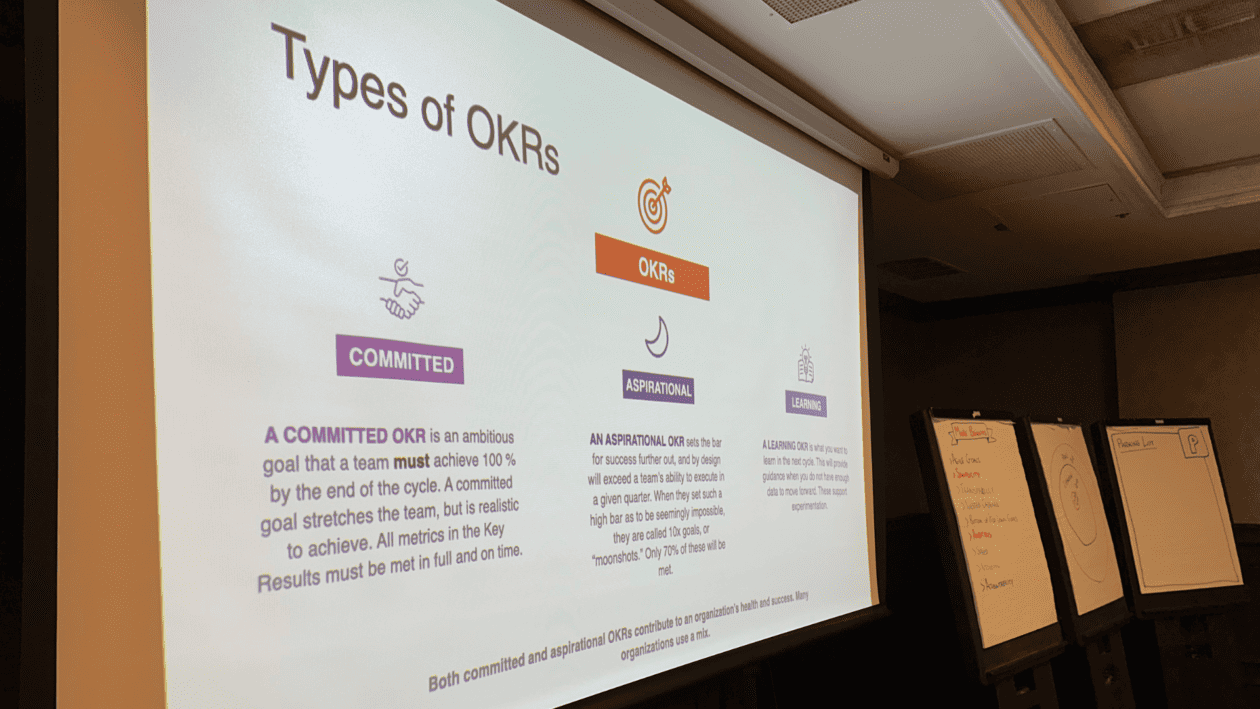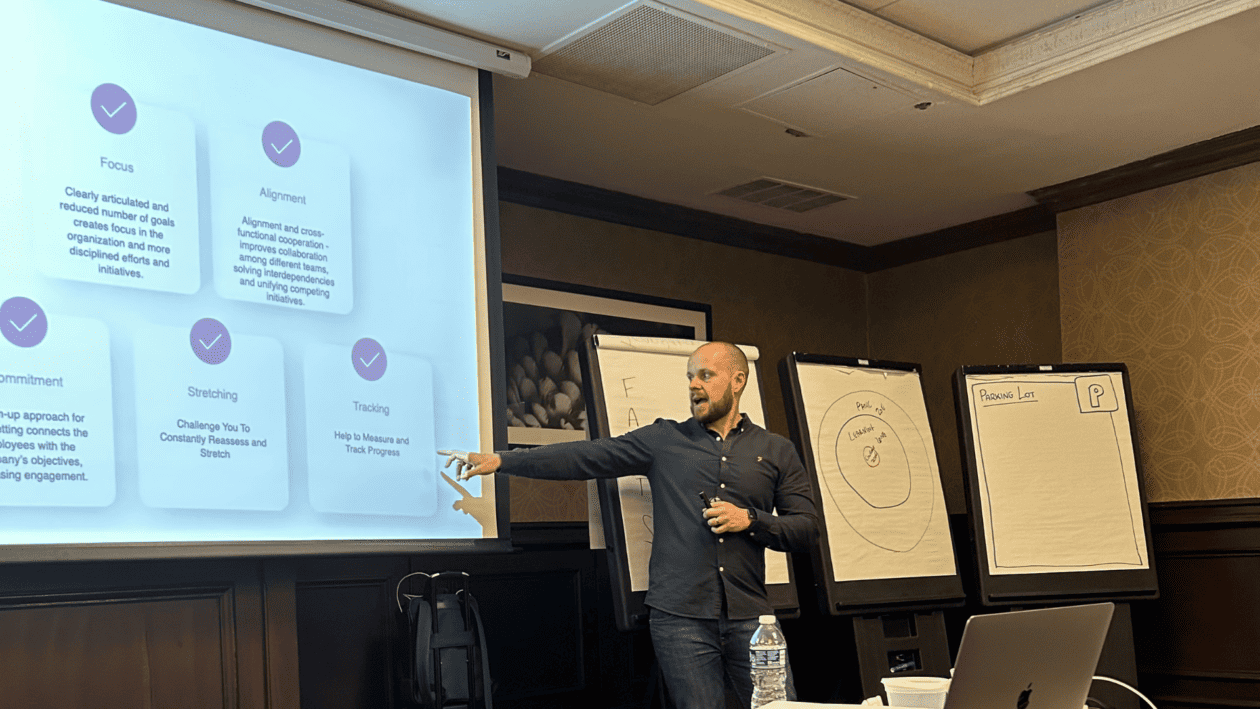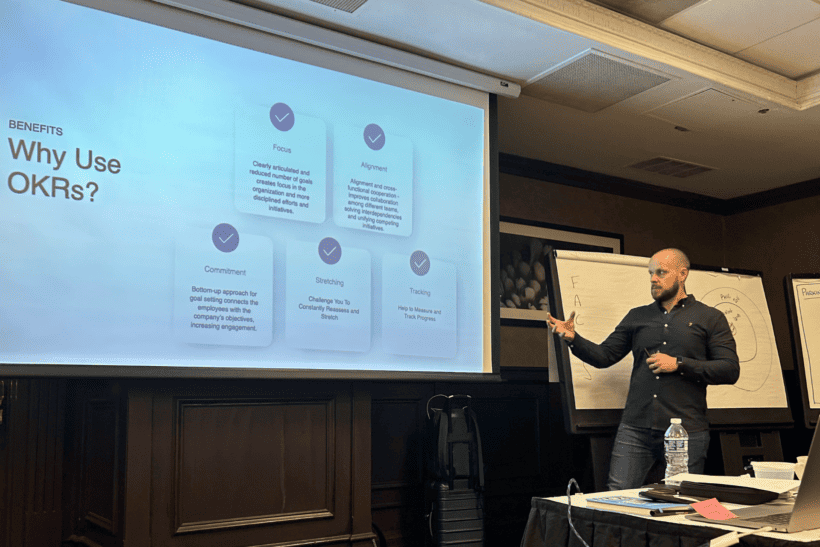As we approach the end of the year, now is the time to consider what our goals are for 2024. One way we help clients to supercharge their goal setting is by running bespoke, internal OKR workshops that ultimately lead to the creation of the actual OKRs that they intend to iterate on ready for the next year.
One such client is a transportation company based in the United States. We were invited to Dallas and Atlanta to run some OKR workshops for them, with the goal of helping them to create OKRs and align their execution engine with their bold vision for next year. Based on that workshop, we wanted to share some of our key takeaways of what you should know about OKRs!
What are OKRs and why are they important?
So, first things first, what are OKRs? OKR stand for Objectives and Key Results. They are more than just a fancy goal setting tool. OKRs are a goal-setting methodology that encourages high fidelity collaboration between leaders, teams, programs and individuals to create inspiring, audacious goals with quantifiable results.
An objective is what you want to achieve and key results are the way you measure achieving the objective.
The 3 important elements of OKRs
1. Align to vision with clarity
It’s critical that all OKRs clearly align with the CEO’s or business’ objective, which is normally the vision and mission of the business. This creates enterprise alignment.
2. Link to targeted results
Consider the outcome, the result. OKRs need to answer the question “what is the quantifiable result of your objective and the impact that it will make?”.
3. Measure, track & monitor
You need a system in place to ensure that all the members of your organisation know what is being measured, how to measure it and how to signal for support.
OKR Examples

Here is a recent example of an OKR that we co-created with a client looking to improve their time to value across the organisation.
Objective:
Connect our strategy with execution to deliver value faster than our customers can handle it.
Key Results:
- Establish our current portfolio metrics and baseline by Q2 22
- Introduce a portfolio cadence to manage our initiatives by the end of Q1 2022
- Reduce our WIP from 79 to 50 by the end of 2022
- Reduce our initiative cycle time from 18 months to 9 months (50%) by the end of 2022
- Increase the predictability of our program teams from 65% to 100% by the end of 2022
What are the benefits of using OKRs?
Aside from giving you a laser focus on working towards your measurable goals, well-crafted OKRs have many other benefits too, such as:
- Create alignment: Creating OKRs means the organisation will align its goals at every level.
- Encourage engagement: OKRs give teams something to rally behind.
- Inspire and motivate: OKRs can empower teams to set aspirational goals that they can work towards.
- Tracking progress: OKRs allow teams and organisations to track their progress toward an agreed upon goal.
- Embrace change with shorter goal cycles: Breaking down OKRs into shorter cycles enables you to respond to change quickly.
- Bring transparency: Agreed OKRs need to be communicated throughout the organisation. This transparency can lead to increased collaboration and productivity.
- Increase autonomy: Keep employees accountable without micromanaging them.
- Increase accountability: Employees will know exactly what is expected of them and they can self-assess their performance.
And above all, and most critically, the biggest benefit of using OKRs is that they bring about cultural change in your organisation to one that is highly collaborative, innovative, ambitious, and agile.
Try our AI-powered strategy and OKR assessment tool to self-assess your strategy and OKR maturity.
Best Practices for Writing OKR Goals
Following our experience of running OKR workshops and working with many leaders and teams to formulate well-crafted OKRs, we have developed a great understanding of how you can write great OKRs and what to avoid. We’ll share those tips and common pitfalls here:
Top 3 Tips For Writing Great OKRs
1. Start with the company vision
Your OKRs should be reflective of where the company wants to go. They should show what your top priorities are, what you need to start doing, paint a picture of success and describe meaningful change. Without this, your OKRs will inspire no one!
2. Do not let a lack of data put you off
We often see an avoidance of certain key results due to a lack of data with clients when developing OKRs. If you identify a key result and you need to baseline the data first, then do it! For example, if you have a key result that says “Increase the number of repeat sales per customer” it is important that you baseline to find our starting point. This will help you to understand how ambitious it is. With a little digging, we can improve this key result 10x by reframing it as “Increase the number of repeat sales per customer from X to Y by the end of Q2 2024”
3. Avoid creating OKRs in a silo
One of the quickest and most effective ways to supercharge your OKRs is to get feedback. OKRs encourage collaboration and writing them down should do too. Write them as a team, or present them to a peer, whatever works to help you overcome anything that you are missing.
Top 3 Pitfalls to Avoid When Setting OKRs
1. Less is more
How many objectives do you have and how many key results does each one have? Your OKRs should not spell out your complete list of everything you do. It is a representation of your top priorities. Are you spread too thin? Have you got too much work in progress (WIP)? Whether it’s tasks, user stories, features, epics, projects or strategic priorities, this the biggest productivity killer that we see with our clients.
2. Your day to day is working against your OKRs
Do you start team meetings with your OKRs? Are you constantly challenging yourself on how the work that you’re currently doing moves you towards your OKRs? If the answer to these is “no”, achieving your OKRs is likely at risk. Or maybe your OKRs are not a true reflection of what is important to you and your organisation. If you are not constantly reminding people of what you are aiming for, you are helping them to constantly forget.
3. “Google did it like…”
There is no single ‘correct’ way to successfully implement OKRs. Google provides some great case studies, but what works for them may not work for you. Think about more than just crafting OKRs, consider if you have the execution engine ready to act on them too. The companies who are successful with OKRs invest in training, coaching and practice to make OKRs work for them by building a strong habit of setting ambitious goals and achieving them through solid delivery practices.
Collaborative OKR Workshops

We’ve been running a series of bespoke, internal OKR workshops to help our clients:
- Understand the why behind OKRs
- Identify what a great OKR is made up of
- Practice writing OKRs
- Collaborate on writing their real OKRs together.
These workshops combine theory, practice through experiential learning and case studies and then creating the actual OKRs that they intend to iterate on ready for the next year and/or quarter.
Participants have provided the following feedback on our OKR workshops:
“Aaron was able to articulate in a very engaging way during the breakout sessions that lent to a much easier process for developing our OKRs.”
“If you need to learn about OKRs you need this training.”
Supercharge your goal setting with OKRs
Adopting OKRs can be a cultural shift for many companies, so we strongly recommend investing in your people through training and coaching.
If you are looking for ways to supercharge your goal setting and adoption of OKRs, get in touch for a free Agile Consultation today.


